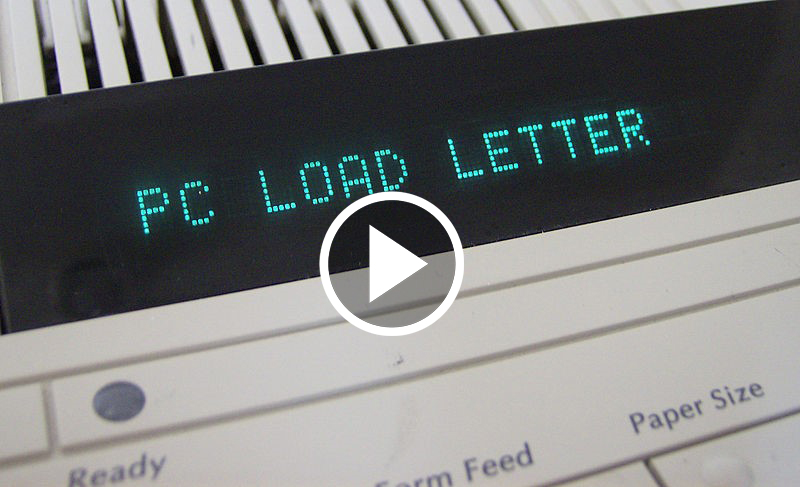Regular readers of this Blog may wonder: “How do you come up with topics to write about?” Well, some postings highlight news like a new product or an interesting conference we attended. Others discuss recent output-related research or market insights. Most others address output issues that our systems engineers or support staff have encountered over the years, but which our Blog readers may not yet have experienced firsthand.
 In choosing topics, we also use analytical tools to see what printing or document keywords people are searching for on the Web. And as it turns out, one popular topic relates to the speed of printing, with searches like network printing slow, slow printing, speed up printing and the like. Which, when you think about it, makes sense. There is almost nothing more frustrating than waiting on a printer so you can continue doing your actual job (as painfully depicted in the famous PC Load Letter scenes in the movie “Office Space”).
In choosing topics, we also use analytical tools to see what printing or document keywords people are searching for on the Web. And as it turns out, one popular topic relates to the speed of printing, with searches like network printing slow, slow printing, speed up printing and the like. Which, when you think about it, makes sense. There is almost nothing more frustrating than waiting on a printer so you can continue doing your actual job (as painfully depicted in the famous PC Load Letter scenes in the movie “Office Space”).
What does “Slow Printing” mean to me?
Judging from the answers found in a quick Google search, one might think the key to improving print speed is to send your document to a 150 page per minute production printer or simply tweak your Windows print drivers or print spooler. In most cases, this won’t cut it.
So how do you speed up printing? Standard Answer #1: “That depends.” LRS has been helping customers to optimize their print workflows since developing our first output management solution in 1981. Ironically, the way we helped that initial customer was to stop sending the print jobs to the fastest printer in the customers’ organization. Instead of printing on the high-speed production printer — which was located in the data center across the street from the end users — we enabled them to print to a somewhat slower network printer right outside the users’ offices.
It all comes down to one question: How do you define “fast?” For simplicity’s sake, let’s define it as the shortest time between a user pressing “Print” and the moment the document is physically in that user’s hands. With that in mind, here are a few ways that LRS helps customers improve the speed of printing:
- Make the document travel to the user, not the other way around. Not so long ago, this involved managing connections to hundreds or thousands of personal printers across your user community. Today, most organizations have eliminated personal printers in favor of fewer powerful, cost-efficient multifunction printers. LRS software makes these far easier to manage. But in today’s business climate, in which employees may move from one location to another, finding the “closest” printer may present a challenge. Our Pull Printing and printer portal solutions ensure the output prints where the user is standing right now, instead of near their regular work location.
- Prevent and quickly resolve printing errors. As in the example from the movie “Office Space,” printing errors greatly delay print delivery. Years ago, LRS developers looked at all of the major operating system print spoolers and saw that none of them delivered the necessary throughput and reliability. So we built our own multi-threaded, multitasking document spool designed for error recoverability and high performance. In case of a printer hardware error or paper problem, documents can be automatically re-routed to an alternate device. All in the name of getting the document to the end user as fast as possible. Those problems that do occur can be quickly located and resolved via a web interface.
- Minimize network impact of individual print jobs. Depending on the size and nature of a document, printing really can impact network performance. LRS software supports a variety of network optimization techniques, including the use of the LRSQ protocol, which offers more than 90% data stream compression. The software can also interrogate incoming print jobs to determine their format, check the capabilities of the target printer, and skip any pre-processing that may slow print delivery. Multiple optimization techniques can be used together where required.
- Minimize overall network impact through Direct IP printing. In the old days, the way to maintain full control over a printing environment was to send all documents through a central print spool. While this can improve print reliability, it can slow down printing if that central spool is located far from the user and/or the target device. Think about a company with a data center in their Australia-based corporate headquarters. Local users in Sydney may see no performance hit by printing through a central spool. However, remote branch users in Dallas, Texas would experience printing delays if every print job had to make a round trip “down under.” LRS software supports a hybrid print architecture that lets some users print directly to a nearby IP device while letting others leverage their secure document spool. All while offering network administrators full auditing capabilities and control.
Are there other ways to speed up printing? Sure, probably too many to list. In more than 40 years of dealing with these issues (especially when networks were a lot slower) we’ve learned a lot. So if slow printing is near the top of your problem list, contact LRS and talk to our output experts.